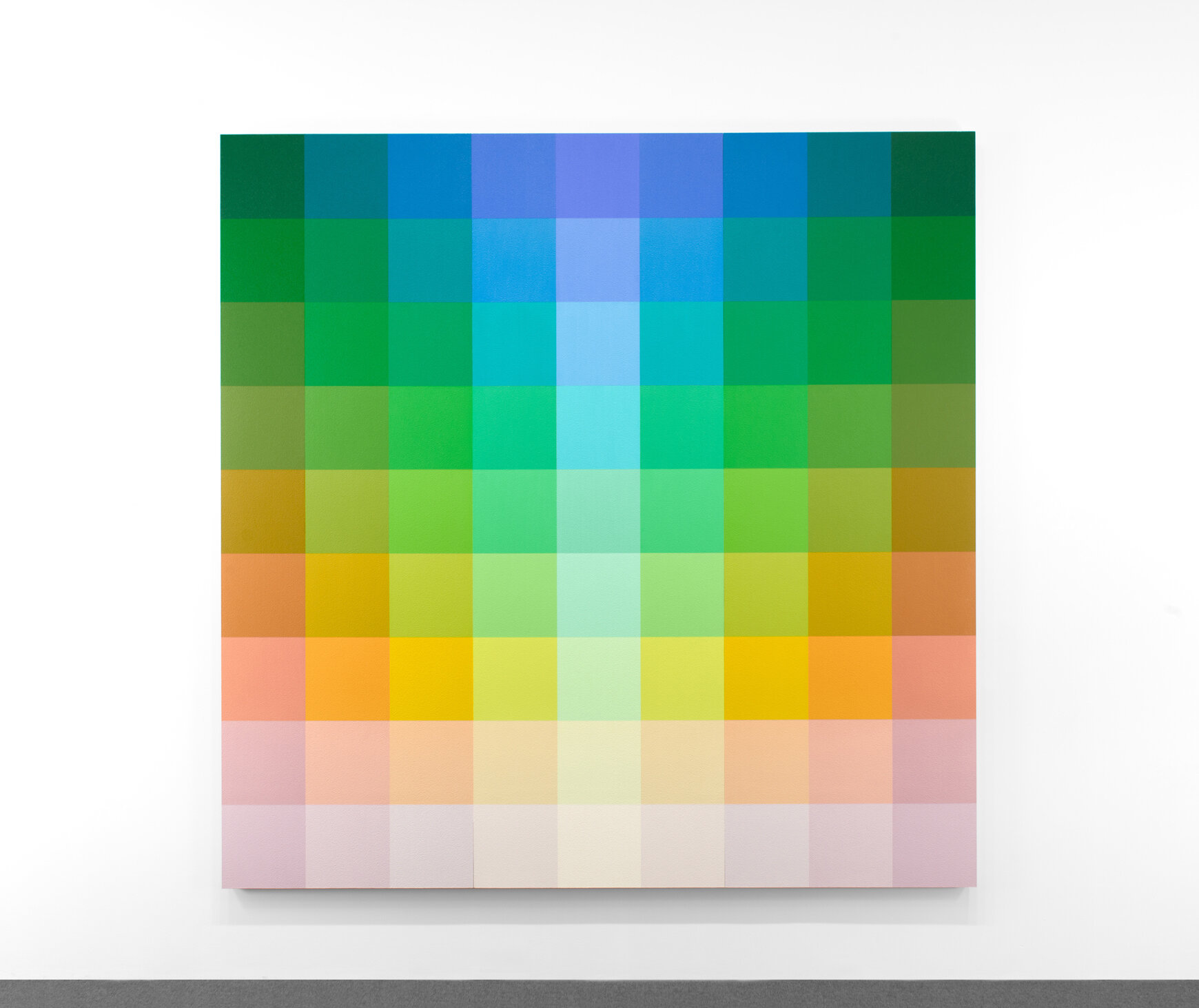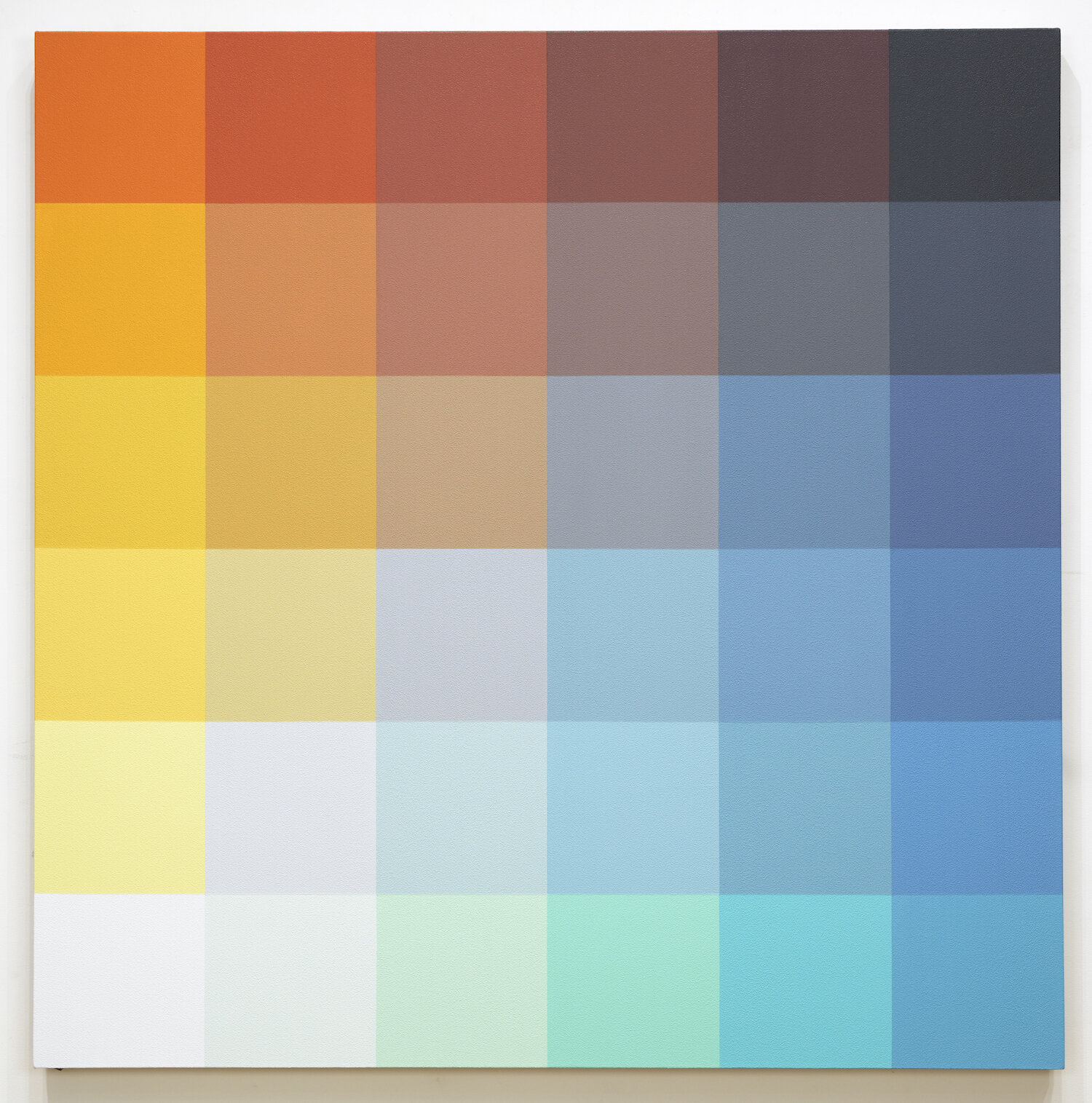Exhibition view of Robert Swain: Immersive Color, MINUS SPACE, 2021
Exhibition view of Robert Swain: Immersive Color, MINUS SPACE, 2021
Exhibition view of Robert Swain: Immersive Color, MINUS SPACE, 2021
Exhibition view of Robert Swain: Immersive Color, MINUS SPACE, 2021
Exhibition view of Robert Swain: Immersive Color, MINUS SPACE, 2021
Exhibition view of Robert Swain: Immersive Color, MINUS SPACE, 2021
Robert Swain, 9 x 9 Red/Orange, 2021, Acrylic on aluminum panels, 9 x 9 feet, 275 x 275 cm, #RS46
Robert Swain, 10 x 12 Green/Red, 2021, Acrylic on aluminum panels, 10 x 12 feet, 305 x 366 cm, #RS47
Robert Swain, 9 x 9 Green, 2021, Acrylic on aluminum panels, 9 x 9 feet, 275 x 275 cm, #RS48
Exhibition view of Robert Swain: Color as Color, MINUS SPACE, Brooklyn, NY, 2017
Exhibition view of Robert Swain: Color as Color, MINUS SPACE, Brooklyn, NY, 2017
Exhibition view of Robert Swain: Color as Color, MINUS SPACE, Brooklyn, NY, 2017
Exhibition view of Robert Swain: Color as Color, MINUS SPACE, Brooklyn, NY, 2017
Exhibition view of Robert Swain: Color as Color, MINUS SPACE, Brooklyn, NY, 2017
Exhibition view of Robert Swain: Color as Color, MINUS SPACE, Brooklyn, NY, 2017
Robert Swain, Untitled, Study for 9x9 Red Green, 2021, Acrylic on canvas, 36 x 36 inches #RS57
Robert Swain, Untitled, Study for 8x8 Green, 2021, Acrylic on canvas, 36 x 36 inches, #RS56
Robert Swain, 8 x 20, Untitled, 2017, Acrylic on panel, 8 x 20 feet, #RS29
Robert Swain, 8 x 16, Untitled, 2017, Acrylic on panel, 8 x 16 feet, #RS28
Robert Swain, 8 x 12, Untitled, 2017, Acrylic on panel, 8 x 12 feet, #RS27
Exhibition view of Robert Swain: Color Energy, MINUS SPACE, Brooklyn, NY, 2015
Exhibition view of Robert Swain: Color Energy, MINUS SPACE, Brooklyn, NY, 2015
Exhibition view of Robert Swain: Color Energy, MINUS SPACE, Brooklyn, NY, 2015
Exhibition view of Robert Swain: Color Energy, MINUS SPACE, Brooklyn, NY, 2015
Exhibition view of Robert Swain: Color Energy, MINUS SPACE, Brooklyn, NY, 2015
Robert Swain, Untitled, 9x9 13HH Red, 2015, Acrylic on birch panel, 9 x 9 feet, #RS07
Robert Swain, Untitled, 9x9 29-15/7E Green, 2015, Acrylic on birch panel, 9 x 9 feet, #RS08
Robert Swain, Untitled, 9x9-6X1, 2015, Acrylic on birch panel, 9 x 9 feet, #RS09
Robert Swain, 7x7-26x6RG, 2020, Acrylic on aluminum, 7 x 7 inches
Robert Swain, 7x7-Red &Green, 2019, Acrylic on aluminum panels, 7 x 7 feet
Robert Swain, 7x7-3x15F, 2015, Acrylic on canvas, 7 x 7 feet
Robert Swain, 7x7-19 x 29BB, 2016, Acrylic on canvas, 7 x 7 feet
Robert Swain, 7x7-5B, 2015, Acrylic on canvas, 7 x 7 feet
Robert Swain, 6x6-2x22, 2020, Acrylic on canvas, 6 x 6 feet
Robert Swain, 5x5-3x21, 2020, Acrylic on canvas, 5 x 5 feet
Robert Swain, 5x5-21, 2015, Acrylic on canvas, 5 x 5 feet
Robert Swain, 5x5-35A, 2015, Acrylic on canvas, 5 x 5 feet
Robert Swain, 5x5-1X23, 2015, Acrylic on canvas, 5 x 5 feet
Robert Swain, Untitled, Study for 9x9–Red Orange, 2021, Acrylic on birch plywood, 35 x 35 inches framed, Image size 27 x 27 inches, #RS63
Robert Swain, Untitled, Study for 9x9-6x1, 2015, Acrylic on canvas, 36 x 36 inches, #RS24
Robert Swain, Untitled, Study for 7x7-19x29BB, 2015, Acrylic on canvas, 36 x 36 inches, #RS51
Robert Swain, Untitled, Study for 5x5-17-1A, 2016, Acrylic on canvas, 30 x 30 inches, #RS50
Robert Swain, Untitled, Study for 6x6 - 9x29, 2016, Acrylic on canvas, 30 x 30 inches, #RS34
Robert Swain, Untitled, Study for 5x5-1x23, 2015, Acrylic on canvas, 30 x 30 inches, #RS49
Robert Swain, Untitled, Study for 6x6 - 27 Red #1, 2016, Acrylic on canvas, 30 x 30 inches, #RS35
Biography
Robert Swain is one of the most influential artists of his generation. He was born in Austin, Texas, in 1940, and grew up in Arlington, Virginia. During high school in the late 1950s, he spent his summers in Guatemala and Nicaragua working on the Pan-American Highway. He attended The American University in Washington, DC, where he later received a BA in Fine Art in 1964. During his undergraduate studies, he spent two years in Madrid, Spain, studying at the University of Madrid. In 1964, he moved to Provincetown, Massachusetts, and worked as a studio assistant to the American Modernist painter Karl Knaths. Swain moved to NYC in 1965 where he permanently settled in Manhattan’s Tribeca neighborhood.
In 1966, Swain began his first color-based work followed a year later by his first work utilizing the grid. He participated in his first group exhibition, Light and Line, organized by John Baldwin at the legendary Park Place Gallery in NYC in 1967. That same year he met sculptor Tony Smith who became his close friend and mentor for many years. In 1969, Swain began to develop his own color system, a project that continues until today.
Swain has exhibited his work nationally and internationally for more than 40 years. His paintings have been including in countless landmark exhibitions. He participated in the seminal exhibition Art of the Real curated by Eugene Goossen at the Museum of Modern Art, NYC, in 1968. The exhibition traveled for the next two years to the Grand Palais, Paris, France; Kunsthaus, Zurich, Switzerland; and The Tate Gallery, London, England. Swain exhibited in The Structure of Color curated by Marcia Tucker at the Whitney Museum of American Art, NYC, in 1971.
In 1974, he mounted his first solo museum exhibition at The Everson Art Museum, Syracuse, New York. In 1974, he participated in Color as Language curated by Kynaston McShine and organized by the International Council of the Museum of Modern Art, which traveled throughout Central and South America, including to the Museo de Arte Moderno, Bogota, Colombia; Museo de Arte Moderno de Sao Paulo, Brazil; Museo de Arte Moderno, Rio de Janeiro, Brazil; Museo de Bellas Artes, Caracas, Venezuela; and Museo de Arte Moderno, Mexico City, Mexico. His work was also twice included in the Corcoran Biennial at The Corcoran Gallery of Art in Washington, DC (1969, 1998).
Swain’s work is represented in nearly 300 public and private collections, including the Metropolitan Museum of Art, Corcoran Gallery of Art, Walker Art Center, Albright-Knox Art Gallery, Milwaukee Art Museum, Denver Art Museum, Detroit Institute of Art, Everson Art Museum, Virginia Museum of Fine Arts, and Columbus Gallery of Fine Arts, among others. He has completed major commissions for IBM, Johnson & Johnson, American Republic Insurance Company, Schering Laboratories, Harris Bank, Travenol Laboratories, Tupperware World Headquarters, and the University of Buffalo. He has received awards from the John Simon Guggenheim Memorial Foundation, National Endowment for the Arts (1976, 1989), New York State Council on the Arts, and the City University of New York.
In addition to his artistic work, Swain taught in the Department of Art & Art History at Hunter College from 1968-2014, where he educated and mentored countless generations of artists. For his teaching, he was awarded the Distinguished Teaching of Art Award from the College Art Association in 1998.
In 2010, Swain was the subject of a major 45-year survey exhibition entitled Visual Sensations: The Paintings of Robert Swain curated by Gabriele Evertz at Hunter College/Times Square Gallery, NYC. In 2014, he installed a major exhibition of large paintings entitled The Form of Color at the Santa Monica Museum of Art, Santa Monica, CA, curated by Jeffrey Uslip.
Statement
Color is a form of energy derived from the electromagnetic spectrum that stimulates our perceptual processes and is instrumental in conveying emotions. In some instances, color is culturally encoded, projecting content through symbolism or associations. The origin for such references are found in the way that the energy (wavelengths), from a particular color, generates feeling; a physiological change produced by the wavelength (energy), of a particular color or colors. The energy which emanates from green is distinctly different from the wavelengths that define red. In some cultures, pure red is associated with danger. Feelings and attitudes created by the aggressive, radiate energy, which is unique to the red part of the spectrum. When pure red is altered, its emotional attributes change, as in the stability associated with red earth colors, or the whimsical fluctuation produced by pink. In this sense, color transmits feeling(s) through the perception of energy (wavelengths) from the electromagnetic spectrum. Freed from cultural restraints, red can be experienced by itself as a phenomenon, which possesses substantial content. When red is placed next to green, the contrast is heightened, as M. E. Chevreul has observed, and the experience resides in the energy generated by the convergence of these unique spectral wavelengths.
Gallery Exhibitions
Twenty, June 24 - September 30, 2023
Robert Swain: Immersive Color, September 11 - December 18, 2021
Untitled (Summer), July 19 - August 24, 2019
Robert Swain: Color as Color, March 4 – April 29, 2017
Robert Swain: Color Energy, May 30 – July 4, 2015
Pointing a Telescope at the Sun, August 6 – September 17, 2011
Robert Swain: Primary Research, October 23 – December 4, 2010
Escape from New York, Sydney Non Objective, Sydney, Australia, August 3 – September 2, 2007
Videos
In the Studio with Robert Swain, American Abstract Artists, May 3, 2022
Robert Swain Artist Talk, MINUS SPACE, September 23, 2021
Panel Discussion of Robert Swain Paintings, 375 Hudson Street, 2018
Robert Swain and Introducing the new MINUS SPACE, James Kalm Report, 2015
Visual Sensations: The Paintings of Robert Swain, by Mitch Fatel, 2015
Robert Swain at Hunter College and MINUS SPACE, James Kalm Report, 2010
Conversations with Robert Swain, Interview with Matthew Deleget, Directed and edited by Peter Canale, Stocan Films, 2010
Part 1: New York & The Early Years
Part 2: Color System
Part 3: The Grid: Harmony & Contrast
Part 4: Technology & Process
Part 5: The Brushstroke & Beyond
Catalogs
Radiant Energy: Gabriele Evertz, Robert Swain, Sanford Wurmfeld, 2018
Robert Swain: Color as Prime, 2016
Robert Swain: Color Syntax / Recent Paintings, 2018
Robert Swain: Color Syntax / Recent Paintings, Exhibition Views, 2018
Robert Swain: The Form of Color, 2014
Robert Swain: Visual Sensations, The Paintings, 1967-2010, 2010
Optic Nerve: Perceptual Art of the 1960s, Published by Merrell Publishers, 2007 (Amazon)
Web Site
www.robertswainspainting.com
Our Artsy Page
www.artsy.net/minus-space/artist/robert-swain
Social Media
Instagram













































